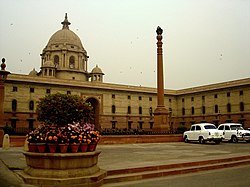| Chief of the Army Staff | |
|---|---|
| सेनाध्यक्ष | |
 | |
| Status | Professional head of land forces branch of the Indian Armed Forces. |
| Abbreviation | COAS |
| Member of | Defence Acquisition Council Defence Planning Committee National Security Council |
| Reports to | |
| Residence | Army House, Residence 4, Rajaji Marg, New Delhi |
| Seat | Integrated HQ of MoD (Army), South Block, Central Secretariat, New Delhi |
| Appointer | Appointments Committee of the Cabinet (ACC) |
| Term length | 3 years or at the age of 62, whichever is earlier. (no renewal) |
| Constituting instrument | Army Act, 1950 (Act No. 46 of 1950) |
| Precursor | Chief of the Army Staff and Commander-in-Chief, Indian Army |
| Formation | 21 June 1948 |
| First holder | General Rob Lockhart |
| Deputy | |
| Salary | Pay level 18 ₹250,000 (US$3,000) monthly [1] [2] |
The Chief of the Army Staff (COAS) is a statutory office held by the professional head of the Indian Army (IA), the land forces branch of the Indian Armed Forces. [3] Customarily held by a four-star general officer, the COAS is the senior-most operational officer of the IA, tasked with the roles of overseeing the overall functioning of the force during peace and wartime, committing to the preparation and maintenance of the force's operational effectiveness and defending the nation's territorial integrity and sovereignty. [4]
Contents
- Description
- Roles and responsibilities
- Structure
- Promotion
- Tenure
- History
- Pre-independence era (1748–1947)
- Dominion-era (1947–1950)
- Republic-era (1950–present)
- Appointees
- List of chiefs of the Army Staff
- See also
- Former command offices
- Other offices of the Indian Armed Forces
- History 2
- Notes
- References
- Sources
Being a permanent member of the Chiefs of Staff Committee (COSC) and the National Security Council (NSC), the COAS also bears the responsibility of advising the nation's civilian leadership i.e., the Government of India on all matters privy to the IA. [5]
Statutorily, the COAS ranks 12th-overall in the Indian order of precedence, and is the IA's status-equivalent of the Chief of Defence Staff, the Chief of the Naval Staff and the Chief of the Air Staff - all three positions of which are also occupied by four-star officers from the armed forces. [6]

































